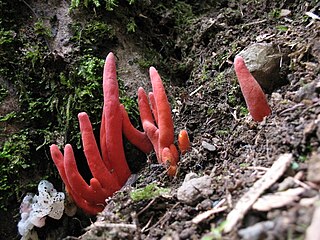
The Hypocreales are an order of fungi within the class Sordariomycetes. In 2008, it was estimated that it contained some 237 genera, and 2647 species in seven families. Since then, a considerable number of further taxa have been identified, including an additional family, the Stachybotryaceae. Wijayawardene et al. in 2020 added more families and genera to the order. According to the Catalog of Life, As of April 2021 the Hypocreales contains 6 families, 137 genera, and 1411 species. Hyde et al. (2020a) listed 14 families under Hypocreales, while, Wijayawardene et al. (2022) accepted 15 families in the order, where Cylindriaceae was additionally added. Earlier, Hyde et al. (2020a) had placed Cylindriaceae in class Xylariomycetidae. Samarakoon et al. (2022) agreed. Hence, Cylindriaceae should have been excluded from Hypocreales and placed in Xylariomycetidae. Xiao et al. (2022) recently introduced a new family Polycephalomycetaceae to Hypocreales.

Hypocreomycetidae is a subclass of sac fungi.

The Bionectriaceae are a family of fungi in the order Hypocreales. A 2008 estimate places 35 genera and 281 species in the family. Species in the family tend to grow on plant material, including woody debris, while some species associate with algae, bryophytes, or other fungi.
The Trichosphaeriales are an order of sac fungi. It is monotypic, and consists of the single family, the Trichosphaeriaceae. In 2017, the family of Trichosphaeriaceae was placed in Diaporthomycetidae families incertae sedis, which was accepted by Wijayawardene et al. (2018), and Wijayawardene et al. 2020. The order of Trichosphaeriales was also unplaced. They are generally saprobic and pathogenic on plants, commonly isolated from herbivore dung.

Annulatascus is a genus of fungi in the Annulatascaceae family of the Ascomycota. The relationship of this taxon to other taxa within the Sordariomycetes class is unknown, and it has not yet been placed with certainty into any order. The genus is characterized by taxa that are saprobic on submerged, decaying plant material in freshwater habitats. Morphologically the taxa possess dark brown to black perithecia, long tapering hyaline septate paraphyses, eight-spored asci with relatively massive J− apical rings, and ascospores that may or may not possess gelatinous sheaths or appendages. There are currently 17 species included in the genus.
Evan Benjamin Gareth Jones is a British mycologist. His main area of research interest is aquatic fungi, particularly marine fungi. He has supervised about 100 PhD and MSc students, published approximately 600 research articles and is a highly cited scientist. Other research interests include marine biofouling, biodeterioration of materials, and wood decay by fungi.
Lulworthiomycetidae is a subclass of Sordariomycetes.
Savoryellomycetidae is a subclass of sac fungi within the class of Sordariomycetes. It contains 4 known orders of Conioscyphales, Fuscosporellales, Pleurotheciales and Savoryellales.
Conioscypha is a genus of terrestrial and freshwater fungi in the monotypic family Conioscyphaceae and the monotypic order Conioscyphales. They are found on decayed wood, leaves, or bamboo stems. Except for Conioscypha japonica which was isolated from dog skin fragments and hair in 2017.
Conioscyphales is an order of freshwater and terrestrial fungi within the division Ascomycota. It is in the subclass Savoryellomycetidae and the class Sordariomycetes and the subdivision of Pezizomycotina.
Fuscosporellales is an order of fungi within the phylum of Ascomycota and in the class Sordariomycetes and subdivision of Pezizomycotina.

Savoryellaceae is a family of aquatic based fungi. It is the only family in the monotypic order Savoryellales within the class Sordariomycetes, division Ascomycota.

Savoryella is a genus of freshwater and marine based fungi in the family Savoryellaceae and the order Savoryellales.
Fuscosporella is a genus of terrestrial and freshwater fungi in the family Fuscosporellaceae and within the monotypic order of Fuscosporellales.
Pseudodactylaria are a genus of fungi, within the monotypic family PseudodactylariaceaeCrous, and within the monotypic order PseudodactylarialesCrous, within the class Sordariomycetes. They are saprobic on plants in freshwater or terrestrial habitats.

The Torpedosporales are an order of marine based fungi in the class Sordariomycetes, subclass Hypocreomycetidae. Most are found on wood substrates in the water.
Etheirophoraceae is a family of ascomycetous marine based fungi within the order of Torpedosporales in the subclass Hypocreomycetidae and within the class Sordariomycetes. They are saprobic on intertidal wood and bark within marine habitats.

Juncigenaceae is a family of ascomycetous marine based fungi within the order of Torpedosporales in the subclass Hypocreomycetidae and within the class Sordariomycetes. They are saprobic to intertidal wood, within mangrove forests and other herbaceous wood and roots, bark, leaves in various marine habitats.
Torpedosporaceae is a monotypic family of ascomycetous marine based fungi within the order of Torpedosporales in the subclass Hypocreomycetidae and within the class Sordariomycetes. They are saprobic on intertidal mangrove wood and roots, bark leaves, and sand in various marine habitats.
Falcocladium is a genus of fungi, within the monotypic family FalcocladiaceaeSomrith., E.B.G. Jones & K.L. Pang, and within the monotypic order FalcocladialesR.H. Perera, Maharachch., Somrith., Suetrong & K.D. Hyde, within the class Dothideomycetes. They are saprobic on leaf litter, including the leaves of Eucalyptus grandis and Eucalyptus camaldulensis in tropical and terrestrial habitats.







